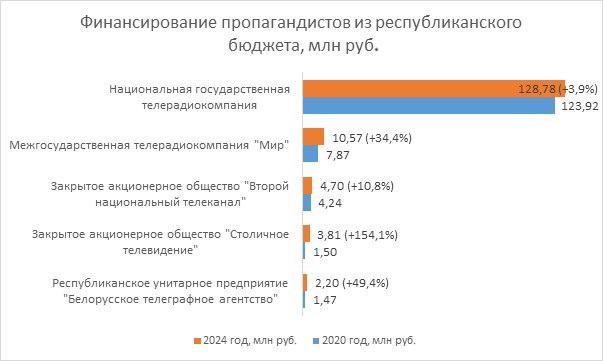The government has generously increased funding for the law enforcement agencies but cut spending on propaganda.

Top ten recipients
Unfortunately, there is not much data in the public domain, except target figures for the national budget. But even available data is enough to track some interesting trends. The local budgets are not included in the analysis.
Let’s compare how the top ten recipients have changed since 2020. The list is basically the same as four years ago. The only newcomer is the Emergency Management Ministry, which entered the top 10 for the first time in 2024, taking 10th place. In 2020, the Ministry of Labor and Social Security was in 10th place. In 2020, rescuers earned points by clearing Minsk of the opposition flags, ribbons and even red and white underwear.
Top ten recipients, 2024, million rubels
- Ministry of Defense
- Ministry of Health
- Ministry of Industry
- Biełarusbank
- Ministry of Transportation and Supply Lines
- Social Security Fund of the Ministry of Labor and Social Security
- Ministry of Internal Affairs
- Ministry of Education
- Ministry of Agriculture and Foodstuffs
- Emergency Management Ministry

Since 2020, the Ministry of Defense went from second to first after the government increased defense spending in connection with the Russian war against Ukraine. The former top beneficiary, the Social Security Fund (SSF), slipped to sixth. Apparently, the government does not prioritize pensions and social benefits.
The Ministry of Health climbed from fourth to second; its funding has increased sharply during the coronavirus pandemic. Besides, nearly 80 percent of health funding comes from local budgets.
The Ministry of Industry moved up from ninth to third as the economy requires more budgetary support to avert a crisis. Otherwise, there were no other notable changes in the top ten.
The cumulative inflation was 41 percent from January 1, 2020 to December 31, 2023. Meanwhile, the funding for the top 10 increased even more, so the growth was real.
The Ministry of Industry enjoyed nearly a threefold increase in financial injections from 561 million rubels in 2020 to 2,234 million in 2024.
The Ministry of Defense ranks second, with rise of 160 percent from 1,469 to 3,818 million rubels. The Ministry of Health comes third, with 99 percent from 1,187 to 2,361 million rubels.
The only agency in the top ten to record a decrease is the SSF, down 10 percent from 2,014 to 1,809 million rubels.
The SSF is an extra-budgetary fund with its own revenues mainly coming from social insurance contributions. Every employed person pays 35 percent to the SSF, and the fund pays pensions, benefits and sick leaves.
The SSF’s revenue is projected at 28 billion rubels in 2024, while state budget revenue is to total 45 billion rubels.
The government is to transfer 2 billion rubels from the state budget to the SSF to finance a deficit.
From 2020 to 2024, SSF revenue is slated to grow by 64 percent. Adjusted for the 41 percent inflation, the real increase is over 20 percent.
Security agencies take cream off budget cake
The government doubled spending on law enforcement, security and defense agencies.
In the full list of recipients, there are about 20 law enforcement and security agencies, including the Committee for State Security (KGB), the Presidential Security Service, the Constitutional Court and the Prosecutor General’s Office.
Even Biełarusbank is responsible for financing the military: of the 2.1 billion rubels the bank will receive from the government this year, 1.8 billion will be spent to pay pensions to retired military officers. Unlike other pensioners, the military receive their pensions from the state budget, not from the SSF. Thus, four of the top 10 are related to law enforcement in one way or another. The list of the law enforcement, security and defense agencies below does not include Biełarusbank.

In 2024, at least 9 billion rubels will be allocated for financing law enforcement bodies. Almost 8 billion rubels, or 17 percent of the total state budget expenditures, will go toward other agencies, the list of which is not available, so the total defense, security and law enforcement spending may be higher.
Compared with 2020, their funding has increased from 4.2 to 9 billion rubels, or 111.9 percent. Adjusted for inflation, it has grown by about 50 percent outpacing the rise in the overall budget expenditures.
The security spending share increased from 16.6 percent in 2020 to 20.1 percent of the total in 2024.
Less for propaganda
Propagandists defend the regime just like law enforcers. However, their target audiences are different: the law enforcement agencies fight against opponents, while propagandists feed “patriotism” to government supporters and discredit “enemies.” The government increased spending on propaganda only by 8 percent, but adjusted to inflation, the difference is equivalent to a 25 cut.
There are five state media outlets on the list of budget recipients, such as the National State TV and Radio Company, TV Mir, Second National TV Channel, STV and BelTA. In practice, there are more recipients because some data is not available, and local media receive funds from local budgets.
In 2024, the total subsidies for the five propaganda outlets amount to 150.1 million rubels, up from 139 million rubels in 2020.
These outlets’ share of total spending fell from 0.5 percent to a meager 0.3 percent. Except subsidies, the state media also receive advertising revenues, which might have skyrocketed amid the crackdown on the independent media.
Interestingly, funding for the Ministry of Information, which administered the crackdown, plunged by 42 percent, adjusted for inflation, from 29.1 million rubels in 2020 to 24 million rubels.
State media funding, million rubels
State TV and Radio Company
Mir
Second National TV Channel
STV
BelTA

Of these five media, only STV can boast of an increase of more than 100 percent, adjusted for inflation. In real terms, BelTA will receive 8 percent more than in 2020, while the State TV and Radio Company will be given 25 percent less.